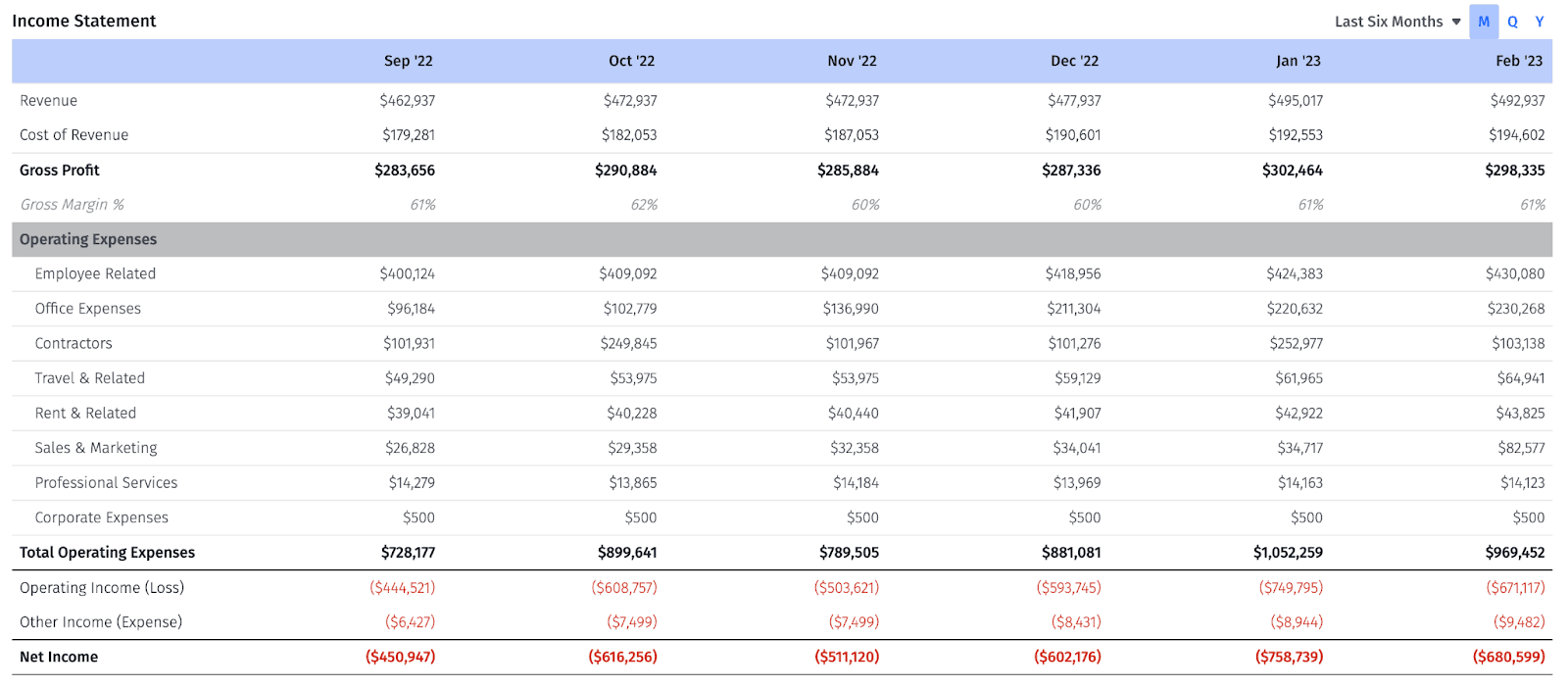The P&L statement is a company’s map to profitability. It’s where you lay out the revenue that’s coming in the door and the expenses flowing out of your business. The figures found on the SaaS P&L statement also form the basic components of several important SaaS metrics, including customer acquisition cost (CAC), churn, annual recurring revenue (ARR), net burn, and more.
But P&L management at SaaS companies is notoriously difficult, especially for earlier-stage companies. Understanding what to pay attention to in your SaaS P&L statement and how to optimize it is fundamental to your ability to drive strategic insights to leaders across your org.
Table of Contents
What Is a P&L Statement in SaaS?
The profit and loss statement or P&L statement (also called an income statement) tells you exactly how much money you’re making as a business. And regardless of industry, a GAAP-compliant income statement includes three main components, which are
- Revenue: How much money the company is making, a.k.a the top line of your SaaS income statement.
- Expenses: How much money the business is spending to make money.
- Net Income: Everything that’s left over when you subtract expenses from revenue, a.k.a the bottom line of the statement.
Profit and loss influence every decision in your business, from SaaS pricing strategy to headcount planning. The SaaS P&L statement helps you determine whether to focus on a top-line vs. bottom-line growth strategy to preserve your cash runway through less spending or find more opportunities to optimize your sales and marketing engine.
And especially for VC-backed companies that operate on loss to drive rapid growth, the P&L statement is a foundational resource to answering two important questions: Can your company make it to the next round of funding in 12-18 months? And is the P&L statement putting up the kinds of numbers investors want to see when considering capital efficiency?
P&L and the Whole Financial Picture
The P&L statement is one of three interlinked financial statements that finance teams analyze to provide deep and valuable insights into a company’s profitability — especially when viewed in relation to each other. The other two financial statements are the following:
- Cash flow statement: Summarizes the movement of cash and cash equivalents as they flow in and out of a business. This includes cash flow from operating activities, as well as from financing and investing activities.
- Balance sheet: Summarizes a business’s assets, liabilities, and shareholder equity.
As a SaaS business matures, a fourth financial statement, the statement of changes in equity (or statement of retained earnings), gains importance. This is where the company tracks equity offered to employees or investors and how much the company keeps after paying out any vested options.
SaaS P&L Example
The SaaS P&L statement includes total revenue, expenses, and other important information. It should organize these categories by month and show each in succession so that users can see trends.
Here’s an example of a SaaS P&L statement.

The SaaS P&L Structure Explained
All P&L statements follow the same general structure (revenue as the top line, net income as the bottom line). But every business will have its own idiosyncrasies. In a SaaS P&L statement, you’ll focus on the following terminology and categories.
Revenue
Revenue refers to the money a business generates from core business operations. At SaaS companies, this generally means money received from subscriptions, tiers of product/feature access, or number of seats/users.
Revenue is the top line of the P&L statement, but it can be broken out further into net sales or net revenue, which accounts for refunds and discounts.
Cost of Revenue
This is a SaaS company’s version of the cost of goods sold (COGS). The cost of revenue includes everything spent acquiring a new customer and retaining existing customers. More than customer acquisition costs, at a SaaS company, cost of revenue includes:
- Hosting fees
- Website-related expenses
- Software license agreements
- Customer support team salaries
- Data communications costs
The remaining costs are tallied under operating expenses.
Gross Profit
Gross profit is the amount of money left over when you subtract the cost of revenue from your company’s net revenue. Gross profit is important because you can use it to calculate your gross margin ratio.
Gross Margin
The gross margin ratio helps you understand how much of each dollar in revenue your company keeps as gross profit. A SaaS company that keeps $.70 of every dollar has a gross profit margin ratio of 70%.
Operating Expenses
Operating expenses (OPEX) account for all the costs a business incurs via normal business operations. Every SaaS business will have its own blend of operating expenses, but the most common categories include:
- Sales and marketing expenses
- Office expenses
- Rent and utilities
- Salaries
- Contractors
- Legal and professional costs
- Professional services
- Corporate expenses
Operating Income
The operating income represents the profit from core business operations. The operating income is generally negative at VC-backed startups due to paying any taxes or interest. It’s still important to include in your P&L statement, as it’s an important part of pitch decks for future investors to understand that the core business is profitable despite any net loss.
Net Income
Net income (also net earnings) is the bottom line of the P&L statement.. It represents the profit left over after all expenses are subtracted from revenue and other sources of income, and indicates whether a business is profitable or trending toward profitability in the case of VC-backed companies.
Shift to Real-Time, Self-Service Financial Reporting
How to Create a SaaS P&L
No two P&L statements are the exactly the same. But the SaaS business model has a few special requirements to set up the P&L properly.
Bookings
Bookings are any executed contract for a SaaS company‘s product or service. While not a formal part of the P&L statement, SaaS bookings are incredibly important to a SaaS business’s cash flow analysis. Adding bookings to the P&L statement or dashboard is generally a good idea as it provides a holistic picture of the company’s cash flow and helps generate important insights into future revenue.
Revenue
If the company offers tiers as part of their pricing strategy, revenue should be separated into revenue streams, with monthly recurring revenue (MRR) divided from one-time sales. Recurring revenue should be further demarcated into variable and contracted amounts.
Cost of Revenue
Finance teams should include everything related to selling their product or services, from personnel training to software fees to application hosting fees and more. This is where customer success and DevOps spending go as well.
Operating Expenses
There are four general categories for operating expenses: cost of revenue, research and development, sales and marketing, and general or administrative costs. When entering operating expenses into the P&L report, be sure to tag the expense with the corresponding category.
Non-Operating Expenses and Income
At most SaaS businesses, non-operating spend is generally incurred via interest expenses on debt, and non-operating income is earned on investments. This section exists to keep those funds separate from other expenses and income.
Tips for Structuring Your SaaS P&L
Keep it simple
There’s already enough to manage, so the easier the P&L management process, the better.
Focus on strategy
The finance team’s job is to ensure the funds are there to support strategic initiatives. And the insights gained via P&L management should inform a strategy that supercharges revenue growth.
Leverage your team
SaaS finance has its nuances, so leveraging your team’s strengths and collaborating with department leaders allows you to gain deeper knowledge, which leads to deeper insights and knowledge-sharing across the business.
Embrace SaaS benchmarking as a high-level guide
While hitting the sweet spot for every SaaS KPI is ideal, that’s not how things typically work out. Executive leadership needs to understand how the nuances of their product and the company’s growth stage impact SaaS benchmarking. Guide the business in this effort with financial storytelling skills that explain the “why” behind the numbers.
Track Your P&L with Mosaic
In the past, finance teams relied on clunky spreadsheets to organize data. This process took days, if not weeks, meaning teams are automatically starting with stale data. To make matters worse, anyone could mistype a figure into a cell and break subtotals or formulas.
Mosaic is a Strategic Finance Platform that provides a holistic view of the company’s financial efficiency and the ability to get the most out of your P&L management. Mosaic helps finance teams optimize:
- Accuracy: Errors in financial reporting can mean the difference between growth and failure, investor interest and disinterest. Mosaic’s financial reporting software integrates with key source systems and pulls data from these systems, which helps to eliminate human error from data manipulation and reconciliation between systems. With your team always working with the right numbers, you can trust the accuracy of your reports when presenting to stakeholders and investors.
- Time savings: Mosaic offers out-of-the-box templates and dashboards, including a P&L statement. And when you pair your SaaS P&L statement with our Topline Planner, your team can spend more time on strategic revenue forecasting and cash flow analysis and less time on data entry.
- Efficiency: When you have access to all the numbers in real time, you cut down on chasing people for information. Finance automation allows you to move quickly through processes, such as the month-end close, that would take hours to weeks to complete. You can easily move through calculations and data gathering and focus on discovering actionable insights that keep the company’s growth momentum going.
The finance team has a unique vantage point at the hub of the entire company’s data, which offers a truly holistic view of the business’s financial performance. Mosaic takes that vantage point to the next level. Schedule a demo to learn more about how Mosaic can amplify your P&L management.
SaaS P&L FAQs
How do you categorize SaaS expenses?
Categorizing SaaS expenses correctly is the basis of financial forecasting. Generally speaking, expenses can be tagged under one of four categories:
- Cost of revenue: Expenses directly related to generating revenue, such as fees for web services, software licensing, and vendor fees.
- Sales and marketing: Expenses related to getting the product to reach the target market, such as social media advertising, SEO development, and email marketing costs.
- Research and development: Expenses related to developing, updating, and maintaining SaaS products. Service fees for products like Dropbox, SurveyMonkey, and Zendesk can be categorized as R&D expenses.
- General and administrative costs: Expenses related to operational finance management and general business overhead for day-to-day operations, like insurance, internet, and utility bills.
What is a good P&L ratio in SaaS?
Can you create a P&L statement in Excel?
Own the of your business.

